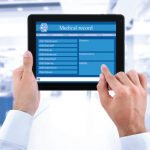
As electronic health records (EHRs) become ever more common in medicine, quality communication between clinicians has paradoxically declined. This is evidenced in the challenges experienced in handoffs of clinical responsibility between clinicians, difficulty in communications between inpatient and outpatient providers, and in the decline of meaningful communications between care team members focusing on a single patient within a specific setting of care. The EHR must above all else facilitate clinical communications. A renewal and a transformation of the busy clinician’s capacity to record and to understand clinical information within EHRs are needed.
Electronic vs. Paper Records
EHRs and legacy paper clinical records differ in multiple, fundamental ways. The first of these is that there is a presumption of many providers using the same EHR record. The distribution and availability of the EHR is limited only by the technology of electronic distribution and whatever limitations are needed to secure privacy and security. The paper record is constrained by its physical possession. The EHR is a comprehensive record of the patient’s care, including many items of little interest to the clinician; the paper record is generally dedicated to a clinical narrative. This in turn has led to confusion and likely a transition in the notion of who owns the medical record and for what purpose it is to be used.
These differences may be further characterized in the following manner:
Paper: 1) Physical possession, with little presumption that the available physical chart was, in fact, complete; 2) cryptic, often unreadable notes; with 3) information typically disorganized from reviewers’ perspectives. We argue this led to more personal communication among providers, at least for more complex and seriously ill patients.
EHRs: 1) Observations are more likely to be taken as fact (data) when they appear on a computer screen or a printed page; 2) they are presumed complete and comprehensive, and, therefore, the omission of critical information (in a note, lab or imaging report) suggests the observation has not been made. 3) Readers tend to imbue critical utilized terms with personal meaning; for example, if an electronic chart states the patient is allergic to ibuprofen, the physician likely presumes that means a proven IgE-mediated event, yet a major EHR codes “intolerance” as a type of allergy. 4) Despite these risks, EHRs do offer the opportunity to improve coordination of care among patients, primary care physicians and specialists via near instantaneous sharing of information. 5) Additionally, EHRs provide enormous opportunities for clinical decision support—from drug interaction and allergy warnings to medication calculations and preventive, as well as high-risk, care alerts. 6) With the potential for standardizing care and identifying small patient cohorts among providers and centers, EHRs also offer the promise of improving population health through collaboration and research. That said, many promised EHR benefits do not directly improve the care of healthy persons, nor those with common, acute and transient illness.

